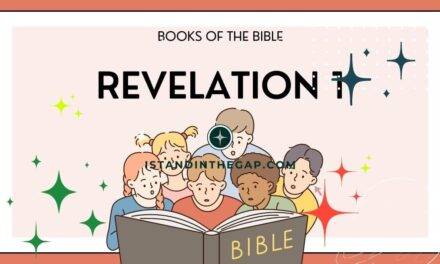Welcome to this detailed exploration of the Book of Revelation! In this comprehensive analysis, we delve into each chapter, unveiling its profound messages, vivid imagery, and spiritual insights. From the majestic opening chapter to the triumphant conclusion, we journey through the captivating visions and symbolic language that define the Revelation narrative.
In Revelation 1, we witness the awe-inspiring revelation of God’s majesty and power. Through John’s encounter with the exalted Christ, we gain a glimpse into the heavenly realm and receive divine instructions for the seven churches. Moving forward, Revelation Chapters 2 and 3 present specific messages addressed to these churches, showcasing both commendation and admonition as they navigate challenges, persevere in faith, and overcome spiritual obstacles.
As we progress to Revelation 4, the scene shifts to the heavenly throne room, where John witnesses an awe-inspiring display of worship and adoration. The subsequent chapter, Revelation 5, introduces the Lamb of God, the central figure in the unfolding drama, whose triumph and worthiness evoke profound praise from heavenly beings.
Revelation 6 propels us into a series of apocalyptic events as the Lamb opens the seals, unveiling God’s judgments upon the earth. The ensuing chapters, namely Revelation 7 and 8, reveal God’s protection over His people amidst turmoil and the unleashing of divine wrath through trumpet judgments, each unveiling a unique facet of God’s plan.
In Revelation 9, we encounter striking visions of demonic forces unleashed upon the earth, as the spiritual battle intensifies. The subsequent chapter, Revelation 10, introduces a powerful angel delivering a bittersweet message, emphasizing the urgency of God’s divine purposes and the role of prophetic revelation.
As we delve into Revelation 11, we witness the emergence of two witnesses and their prophetic testimony, culminating in a dramatic confrontation and ultimate triumph. In Revelation 12, we are transported into a cosmic battle between the woman and the dragon, symbolizing the ongoing struggle between good and evil, with a glimpse into the victory assured by the Lamb.
Revelation 13 uncovers the identities of the beast and false prophet, representing oppressive and deceptive powers that arise in opposition to God’s people. In Revelation 14, we are comforted by messages of hope, celebrating the final harvest and encouraging endurance amid tribulation.
The journey continues in Revelation 15 and 16, where the bowl judgments bring forth divine wrath and culminate in the ultimate battle against evil. Revelation 17 and 18 reveal the mystery of Babylon, exposing the allure and fall of worldly powers and systems, as divine judgment and lamentation ensue.
In Revelation 19, the climactic marriage supper of the Lamb unfolds, signifying the triumph of Christ and the celebration of His redeemed bride. Revelation 20 unveils the concept of the millennial reign, a period of peace and judgment, culminating in the final defeat of evil and the ultimate judgment on the great white throne.
The penultimate chapter, Revelation 21, paints a vivid picture of the new heaven and earth, the descent of the New Jerusalem, and the eternal dwelling of God with His people, bringing a sense of hope and restoration.
Finally, Revelation 22 concludes the divine revelation, emphasizing the urgency of Christ’s return, the eternal blessings for the faithful, and the exhortation to hold fast to God’s Word.
This comprehensive exploration of the Book of Revelation highlights the vivid imagery, prophetic symbolism, and profound spiritual truths contained within each chapter. Join us as we uncover the timeless messages and enduring hope woven throughout this remarkable biblical book.
Revelation Unveiled: Exploring the Prophetic Book of the bible with Vivid Visions and Eternal Hope
The key takeaways from studying the book of Revelation through Rythm stories
Studying the Book of Revelation through rhythmic stories can be a unique and engaging approach. Here are key takeaways from such a study:
- Symbolic Imagery: The Book of Revelation is rich in symbolic language and vivid imagery. Rhythmic stories can help bring these symbols to life, aiding in understanding the deeper meaning behind the text.
- Prophetic Messages: Revelation contains powerful prophetic messages about the future and the ultimate victory of God. Rhythmic storytelling can help convey these messages in a captivating and memorable way.
- Spiritual Battle: The book portrays a cosmic spiritual battle between good and evil. Through rhythmic stories, the intensity and significance of this battle can be emphasized, highlighting the need for believers to stand firm in their faith.
- Hope and Encouragement: Despite the challenges and trials depicted in Revelation, the book ultimately offers hope and encouragement to believers. Rhythmic stories can convey this sense of hope, emphasizing the triumph of God’s kingdom and the promise of eternal life.
- Faithfulness and Perseverance: The stories can underscore the importance of faithfulness and perseverance in the face of adversity. They can highlight the rewards for those who remain steadfast in their commitment to God, inspiring listeners to stay true to their faith.
- Divine Judgment: The rhythmic stories can effectively convey the concept of divine judgment, underscoring the consequences of rejecting God and the need for repentance.
- End-Times Awareness: Studying Revelation through rhythmic stories can cultivate an awareness of end-times events and the significance of Christ’s return. It can remind listeners to live with a sense of urgency and anticipation for His coming.
- Worship and Praise: The rhythmic stories can help capture the spirit of worship and praise that permeates the book. They can inspire a deeper reverence for God and a desire to exalt His name.
- Application to Today: The rhythmic storytelling approach can bridge the gap between the ancient text and modern listeners, facilitating the application of Revelation’s teachings to contemporary life and challenges.
- Awe and Wonder: By presenting the book’s profound truths through rhythmic stories, a sense of awe and wonder can be evoked, inviting listeners to contemplate the mysteries of God’s divine plan and purpose.
Additional Facts about the book of Revelation
- Apocalyptic Literature: The Book of Revelation is a unique genre known as apocalyptic literature. It uses symbolic language, vivid imagery, and visionary experiences to convey spiritual truths and provide insights into the ultimate victory of God over evil.
- Authorship: The book is traditionally attributed to the Apostle John, who wrote it while exiled on the island of Patmos. However, some scholars debate the exact authorship and suggest other possibilities.
- Prophecy and Revelation: The Book of Revelation contains prophecies and revelations regarding future events, both in the near and distant future. It offers a vision of God’s sovereignty, the return of Jesus Christ, the final judgment, and the establishment of the new heaven and earth.
- Symbolism and Imagery: Revelation is filled with symbolic language and vivid imagery that requires careful interpretation. The use of numbers, animals, colors, and other symbols enhances the prophetic messages conveyed throughout the book.
- Messages to the Seven Churches: The initial chapters of Revelation contain specific messages addressed to seven churches in Asia Minor. These messages highlight commendations, rebukes, and exhortations to the respective congregations, providing valuable insights into both their historical context and broader application to churches today.
- Spiritual Battle: The Book of Revelation depicts an ongoing spiritual battle between God and the forces of evil. It unveils the conflict between the Lamb (representing Christ) and the dragon (representing Satan), illustrating the struggle between righteousness and wickedness.
- End-Time Events: Revelation includes descriptions of various end-time events, such as the Great Tribulation, the rise of the Antichrist, the mark of the beast, and the battle of Armageddon. These events represent cosmic struggles and the ultimate triumph of God’s kingdom.
- Hope and Encouragement: While Revelation can contain intense imagery and themes of judgment, it ultimately offers hope and encouragement to believers. It emphasizes God’s ultimate victory, the rewards for faithfulness, and the promise of eternal life with God in the new heaven and earth.














